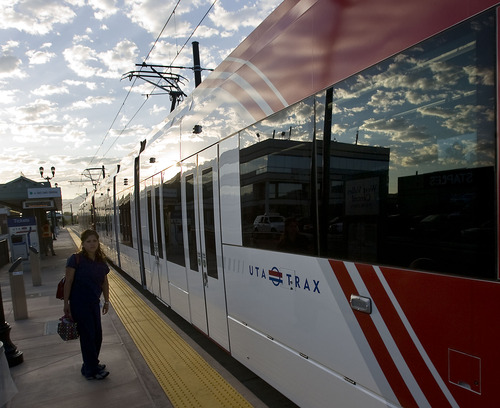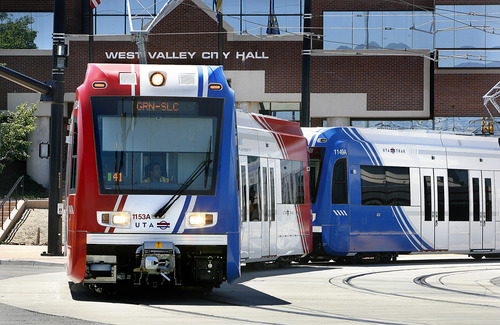This is an archived article that was published on sltrib.com in 2013, and information in the article may be outdated. It is provided only for personal research purposes and may not be reprinted.
Utah's transportation needs are accelerating much faster than revenues — so the state would need to impose tens of billions of dollars of new taxes over the next 30 years to keep pace, a new study by the Utah Foundation says.
For highways, that may include such things as raising fuel taxes; indexing them to rise automatically with inflation; adding sales tax on top of fuel tax; raising registration fees; charging a new tax per mile traveled; or charging tolls that may vary by level of congestion on different roads or lanes.
For mass transit, that may include raising fares; raising sales taxes that support transit; raising taxes on hotel rooms or rental cars; or enacting a new property tax for transit.
"Frankly, nobody will like what we do. But we've got to do something," said Sen. Kevin Van Tassell, R-Vernal, chairman of the state Senate Transportation, Public Utilities and Technology Committee. "Even people who have opposed raising taxes have gotten to the point they see that something needs to be done."
The new Utah Foundation study released Tuesday notes that the state's Unified Transportation Plan figures that through 2040, the state will face high-priority transportation needs costing at least $54.7 billion — while total needs would be about $70 billion.
But current taxes and fees will provide only $43.4 million in revenue in that time — leaving a shortfall of $11.3 billion for high-priority projects. The state's entire annual budget this year weight in at about $13 billion.
"Current revenue sources will not adequately fund the future needs of Utah's transportation system," said Utah Foundation President Stephen Kroes.
Van Tassell said state officials already planned to spend much of the coming year studying how best to resolve the problem. Linda Hull, a government relations officer for the Utah Department of Transportation, said UDOT itself is not pushing for any particular changes, but will assist legislators as requested as they study the issue.
Utah Transit Authority spokesman Steve Allnatt said his agency also is aware of the funding gap, encourages officials to seek ways to eliminate it, and "UTA is willing to help in any way we can to set the priorities and study the possibilities."
The study notes that current, lagging highway funding comes largely from a 24.5 cents per gallon state tax that has not been raised since 1997. Van Tassell said revenues from that have decreased recently because vehicles get better mileage, and people have driven less during tough economic times.
The study also notes that "due to inflation, the current rate of 24.5 cents per gallon is equivalent to 17 cents in 1997 [the last time it was raised], two cents below the tax rate at that time." It also said that in 2011, fuel taxes "made up 0.4 percent of the total personal income in Utah, the lowest point in the history of the gas tax."
Utah's gasoline tax is below the national average of 28.6 cents a gallon, and ranks 27th among the 50 states.
Because fuel taxes has not kept up with needs, the study notes the Legislature has almost every year since 1998 shifted money from its general fund to support transportation.
In 2011, the Legislature also decided to set aside 30 percent of any new growth in sales tax revenue for transportation — until it eventually reaches a cap of 17 percent of total sales tax revenue (considered to be, roughly, the percentage of sales tax that comes from automobile-related sales).
Even with that, the study says the current funding system will fall far short as Utah's population is expected to increase by 60 percent in the next three decades.
Among options is to raise more by increasing fuel taxes, and not waiting so long between hikes. The study says several states index fuel taxes to increase automatically with inflation.
"Rural people will say that hits them harder because they are forced to travel more, so they have to pay more," Van Tassell warns. "But then they are also using the highways more."
The study says some states also add sales tax on top of fuel tax — which could generate $10 billion to $20 billion for Utah over 30 years depending on when and how it is done. But the study warns that "a sales tax on gasoline could be viewed as a double-tax on the same product" because of fuel taxes, and "it could be difficult to implement politically."
Among other options is a tax on vehicle miles traveled. Van Tassell said that would taxes vehicles that use electricity or natural gas and now escape tax on gasoline or diesel.
But how to collect that is challenging. Van Tassell said reading an odometer once a year at vehicle registration is an option, but "it could be a big tax that may be tough to afford all at once." The study notes other states are experimenting with using GPS to charge such taxes incrementally.
For mass transit, the study says options include hiking fares — which the Utah Transit Authority already regularly does (and its next increase comes on April 1). An option listed also is to charge fares based on miles traveled, instead of a flat fare for trips of any length. UTA is already working to implement that in coming years.
Another option is to charge parking fees in UTA parking lots — which UTA now does at one West Jordan TRAX station garage, and plans to begin Thursday at a Draper FrontRunner station garage.
The study said the largest revenue-generating option for mass transit would be imposing a new property tax of 0.1 percent across UTA counties, which could generate $5.8 billion over 30 years.
Other less lucrative options include increasing sales taxes by 0.25 percent over UTA's service area, which could generate $3.8 billion over 30 years; increasing hotel taxes by 1 percent, which could generate $139 million; and raising tax on rental cars by 1 percent, which could generate $71 million. —
To see the study







